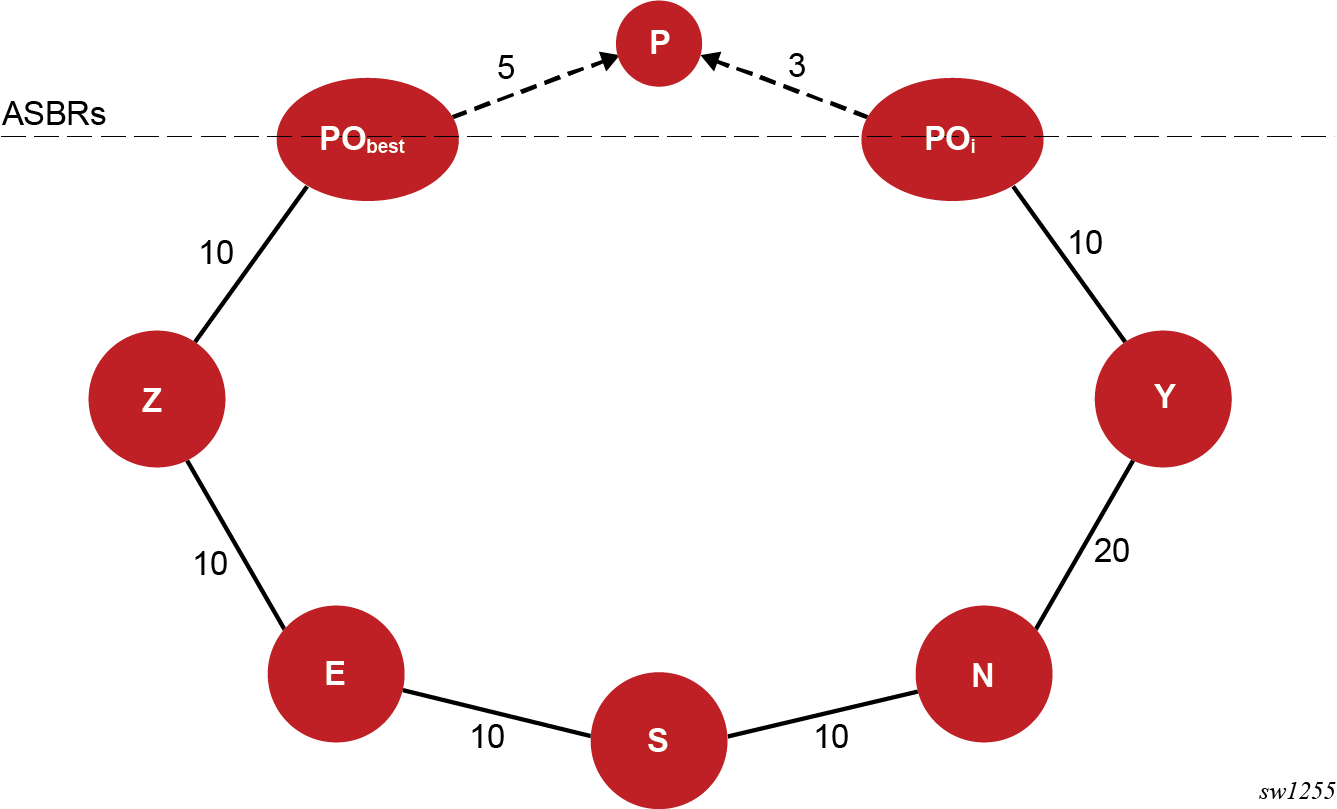This feature uses the multi-homed prefix model described in RFC 8518 to compute a backup IP next hop using an alternate ABR or ASBR for external prefixes and to an alternate router owner for local anycast prefixes.
Note that the scope of the algorithm defined in RFC 8518 is limited to computed backup paths that consist of direct IP next hops and tunneled next hops (IGP shortcuts).
The SR OS implementation also extends the algorithm in RFC 8518 with computing the backup path to an alternate inter-area ASBR. The computed backup paths are added to OSPF routes of external /32 prefixes (OSPFv2 route types 3, 4, 5, and 7) and intra-area /32 anycast prefixes in the RTM if the prefixes are not protected by the base LFA or if the user has set the preference command value to all. The user must enable the ip-fast-reroute command to program these backup paths into the FIB in the data path.
The computed backup path is also programmed for SR-OSPF node SID tunnels of external /32 prefixes and of local /32 anycast prefixes in both algorithm 0 and flexible-algorithm numbers. The backup path, therefore, also extends the protection to any SR-TE LSP or SR policy that uses an SR-OSPF SID of those same prefixes in its configured or computed SID list.
The following figure shows the application of an MHP LFA to IP FRR.

RFC 8518 creates a specific topology for each external prefix by modeling it as a multi-homed node to the Points of Attachment (POi nodes). POi can be an ASBR node for an external prefix or an owner router in the case of an intra-area anycast prefix. The SR OS implementation supports prefixes redistributed by an ABR or ASBR (OSPFv2 route types 3, 5, and 7) and also extends feature support to inter-area ASBR (external routes resolved recursively to OSPFv2 route types 4).
In the topology shown in Figure: Application of MHP LFA to IP FRR, prefix P has a dotted link with a metric of 5 to ABR or ASBR node PObest that summarizes the path in the remote OSPF area or instance to the best ABR or ASBR. Node PObest is ABR or ASBR that lies in the shortest path from the computing node S to the destination prefix P .
Prefix P also has a dotted line to ABR or ASBR POi that summarizes the path to an alternate ABR or ASBR with a cost of 3. Node POi propagates prefix P to the local area or instance of computing node S because its shortest path to P is in the remote area or instance, but POi does not lie in the shortest path to P from the point of view of node S.
Node S computes and finds a MHP LFA backup path for an external prefix P using neighbor N and which uses ABR or ASBR POi to exit the local area or instance, or which uses an alternate owner router for an intra-area anycast prefix, if the following rules are satisfied.
- Protection of Link S-E (1)
D_opt(N,POi) + Cost(POi ,P) < D_opt(N,S) + D_opt(S,PObest) + Cost(PObest ,P)
- Protection of Link E (2)
D_opt(N,POi) + Cost(POi ,P) < D_opt(N,E) + D_opt(E,PObest) + Cost(PObest ,P)
Where, D_opt(X,Y) is the distance on the shortest path from node X to node Y and Cost (X,P) is the external cost to reach prefix P from advertising router X.
The MHP LFA calculation applies to the backup next hop of external OSPFv2 /32 prefixes, propagated across an area or instance boundary, and resolved in RTM when IP FRR is enabled in that OSPFv2 instance. The calculation also applies to /32 prefixes in the same area as the computing node S that are advertised by multiple routers (anycast prefixes).
OSPFv2 runs concurrently the base LFA and the MHP LFA computations.
When the alternate ASBR or ABR node POi receives the packet, it always forwards it to the adjacent area but the path to prefix P in that area may use node PObest. When PObest fails, node S has a non-working backup path, which blackholes packets if activated during that same time until IGP converges. That is, unless the neighbor node of PObest in the adjacent area installed a node protect LFA path to reach P.
However, if node Z computed a multi-homed backup path for prefix P using an alternate ABR or ASBR POi and that path traverses PObest in the adjacent area, a failure of PObest immediately causes a traffic blackhole. This is because node Z has information that the backup path it activated failed after IGP converged in the adjacent area and POi updated the local area.